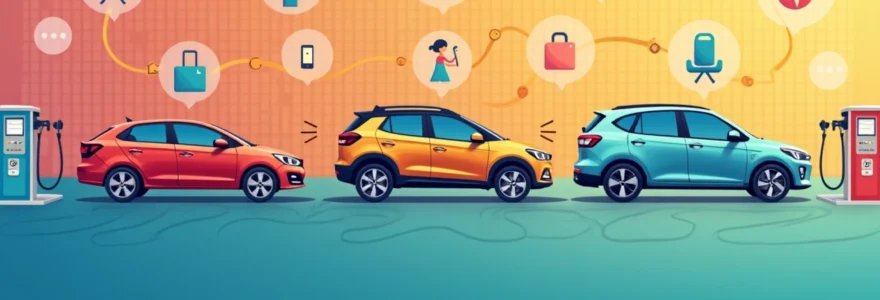Embarking on a holiday adventure with a rental vehicle opens up a world of possibilities. The freedom to explore at your own pace, discover hidden gems off the beaten path, and create unforgettable memories is unparalleled. However, navigating the intricacies of vehicle rental can be daunting for even seasoned travelers. From selecting the right car to understanding insurance options, there's much to consider to ensure your journey is as smooth as the open road ahead. For a seamless experience, consider using platforms like Getaround that offer convenient pickup locations and flexible rental options.
Vehicle selection strategies for optimal holiday experience
Choosing the perfect rental vehicle is crucial for maximizing your holiday enjoyment. Consider the terrain you'll be navigating, the number of passengers, and the amount of luggage you'll be carrying. For city explorations, a compact car might be ideal for easy parking and maneuverability. However, if you're planning to venture into rural areas or tackle mountain roads, a robust SUV or 4x4 might be more suitable.
When browsing options, pay attention to fuel efficiency, especially if you're planning long drives. Hybrid vehicles can be an excellent choice for eco-conscious travelers looking to reduce their carbon footprint while saving on fuel costs. Many rental companies now offer electric vehicles (EVs) in popular tourist destinations, providing an opportunity to experience cutting-edge automotive technology while being environmentally friendly.
Don't overlook the importance of comfort features, especially for extended road trips. Air conditioning, adjustable seats, and a good entertainment system can make a significant difference in your travel experience. If you're traveling with children, ensure the vehicle has appropriate safety features and enough space for car seats.
Navigating rental policies and insurance options
Understanding the fine print of your rental agreement is essential to avoid unexpected costs and ensure peace of mind during your holiday. Take the time to read through the terms and conditions carefully, paying special attention to mileage limits, fuel policies, and any restrictions on where you can take the vehicle.
Comprehensive vs. collision damage waiver (CDW) coverage
One of the most critical decisions you'll make is choosing the right insurance coverage. Comprehensive insurance typically offers the most protection, covering damage to the rental vehicle, theft, and third-party liability. On the other hand, Collision Damage Waiver (CDW) only covers damage to the rental car in the event of a collision.
While CDW might seem like a cost-effective option, it's important to consider the potential out-of-pocket expenses in case of an accident. Many travelers opt for comprehensive coverage for the added peace of mind, especially when driving in unfamiliar territories.
Understanding liability protection limits
Liability protection is another crucial aspect of rental car insurance. This coverage protects you from financial responsibility if you cause injury to others or damage to their property while driving the rental car. Be sure to check the liability limits offered by the rental company and consider whether they're sufficient for your needs.
In some cases, your personal auto insurance or credit card might provide additional coverage. However, it's essential to verify the extent of this coverage before relying on it exclusively. Remember, liability laws can vary significantly between countries, so what's adequate at home might not be sufficient abroad.
International driving permit (IDP) requirements
If you're planning to rent a car in a foreign country, an International Driving Permit (IDP) might be necessary. This document translates your driver's license information into multiple languages and is recognized in over 150 countries. Even if it's not legally required, having an IDP can smooth interactions with local authorities and rental companies.
Obtaining an IDP is usually a straightforward process through your country's automobile association. It's advisable to apply for one well in advance of your trip to avoid any last-minute complications.
Age restrictions and young driver surcharges
Age can be a significant factor in car rental policies. Many companies have minimum age requirements, typically ranging from 21 to 25 years old. Drivers under 25 may face additional fees or restrictions on the types of vehicles they can rent. On the other end of the spectrum, some rental agencies impose upper age limits or require additional documentation for senior drivers.
If you fall into either of these categories, it's worth shopping around to find a rental company with policies that accommodate your needs without excessive surcharges.
Maximizing fuel efficiency and Cost-Effectiveness
Fuel costs can significantly impact your travel budget, especially on longer trips. Implementing strategies to maximize fuel efficiency can help you save money and reduce your environmental impact. Let's explore some effective ways to optimize your rental vehicle's performance and keep fuel costs in check.
Hybrid and electric vehicle options for Eco-Friendly travel
Many rental companies now offer hybrid and electric vehicles as part of their fleet. These eco-friendly options can significantly reduce your fuel costs and carbon footprint. Hybrid vehicles, which combine a gasoline engine with an electric motor, are particularly suitable for trips that involve both city driving and highway cruising.
Fully electric vehicles are becoming increasingly popular in many tourist destinations. While they offer zero emissions and potentially lower operating costs, it's crucial to plan your route around charging stations. Many navigation apps now include EV charging locations, making it easier to plan longer trips.
Route planning with apps like google maps and waze
Efficient route planning is key to minimizing fuel consumption. Utilize navigation apps like Google Maps or Waze to find the most fuel-efficient routes. These apps take into account real-time traffic conditions, road gradients, and speed limits to suggest routes that can save both time and fuel.
Additionally, these apps can help you locate gas stations along your route, allowing you to plan refueling stops at the most cost-effective locations. Some apps even provide fuel price information, enabling you to find the cheapest options in unfamiliar areas.
Utilizing fuel comparison tools like GasBuddy
Apps like GasBuddy can be invaluable for finding the best fuel prices in your area. By comparing prices at nearby stations, you can potentially save significant amounts, especially on longer trips. These tools often include user-reported prices, ensuring you have the most up-to-date information.
Remember to factor in the distance to cheaper gas stations. Sometimes, driving further for slightly cheaper fuel might not be cost-effective when considering the extra fuel used to get there.
Impact of driving habits on fuel consumption
Your driving style can have a substantial impact on fuel efficiency. Adopting smooth, steady driving habits can significantly improve your vehicle's fuel economy. Avoid rapid accelerations and hard braking, maintain a consistent speed on highways, and use cruise control when appropriate.
Additionally, reducing excess weight by removing unnecessary items from the vehicle and minimizing the use of air conditioning can further improve fuel efficiency. However, at high speeds, using air conditioning might be more fuel-efficient than driving with the windows down due to reduced aerodynamic drag.
Enhancing your journey with vehicle Add-Ons and technology
Modern rental vehicles often come equipped with a range of technologies and add-ons that can significantly enhance your travel experience. From navigation systems to safety features, understanding and utilizing these options can make your journey more enjoyable and stress-free.
GPS navigation systems vs. smartphone integration
While many rental cars offer built-in GPS navigation systems, the convenience of using your smartphone for navigation is hard to beat. Most modern vehicles now support Apple CarPlay or Android Auto, allowing you to seamlessly integrate your phone's navigation apps with the car's infotainment system.
This integration not only provides familiar navigation interfaces but also allows access to your music, podcasts, and hands-free calling. However, if you're traveling internationally, be mindful of data roaming charges when using your smartphone for navigation.
Child safety seat regulations across different regions
If you're traveling with young children, understanding local regulations regarding child safety seats is crucial. Requirements can vary significantly between countries and even between states or provinces within a country. Many rental companies offer child seats as an add-on, but availability and quality can vary.
Consider bringing your own child seat if possible, especially for infants or toddlers. This ensures you're familiar with the installation process and can guarantee the seat meets safety standards you're comfortable with.
Roof racks and cargo carriers for extra storage
For travelers with excess luggage or outdoor equipment, roof racks or cargo carriers can be invaluable additions. These add-ons significantly increase your storage capacity, allowing you to keep the vehicle's interior comfortable and clutter-free.
When using roof racks or cargo carriers, be mindful of their impact on fuel efficiency and the vehicle's handling, especially in windy conditions. Secure all items properly to ensure safety and comply with local regulations regarding vehicle height and load distribution.
In-car Wi-Fi hotspots for seamless connectivity
Many rental vehicles now offer in-car Wi-Fi hotspots, providing internet connectivity for all passengers. This feature can be particularly useful for navigating, finding local attractions, or staying connected with work or family during your travels.
While convenient, these services often come with additional fees and data limits. Compare the costs with local SIM card options or portable Wi-Fi devices to find the most cost-effective solution for your connectivity needs.
Exploring Off-the-Beaten-Path destinations with 4x4 rentals
For adventurous travelers looking to explore beyond paved roads, renting a 4x4 vehicle opens up a world of possibilities. These robust vehicles allow you to access remote beaches, mountain trails, and scenic backcountry routes that might be inaccessible with standard rental cars.
When opting for a 4x4 rental, ensure you're familiar with off-road driving techniques and local regulations regarding where you can drive. Many rental companies have specific policies about off-road use, and violating these can result in hefty fines or void your insurance coverage.
Consider the terrain you'll be tackling and choose a vehicle with appropriate ground clearance and features. Some popular tourist destinations offer guided 4x4 tours, which can be an excellent way to experience off-road adventures safely, especially if you're not experienced with this type of driving.
Remember to pack essential supplies when venturing off the beaten path, including extra water, snacks, and a basic tool kit. It's also wise to inform someone of your planned route and expected return time when exploring remote areas.
Streamlining airport pickup and drop-off procedures
The process of picking up and returning your rental vehicle can often be the most stressful part of the experience, especially after a long flight or when rushing to catch a departing plane. Planning ahead and understanding the procedures can help streamline these processes significantly.
For airport pickups, consider joining the rental company's loyalty program if you frequently rent cars. These programs often offer expedited pickup services, allowing you to bypass long queues at the rental counter. Some companies even offer mobile apps that let you select your vehicle in advance and go directly to the parking lot upon arrival.
When returning the vehicle, allow ample time for the inspection process, especially if you need to catch a flight. Many airports now offer off-site rental facilities connected by shuttle buses, so factor in this additional travel time. Use the rental company's express return options if available, which can significantly speed up the process.
Before leaving the rental lot, familiarize yourself with the vehicle's controls and adjust seats, mirrors, and navigation settings. This not only enhances safety but also saves time and reduces stress once you're on the road.
By following these strategies and tips, you can make the most of your holiday with a rental vehicle, ensuring a smooth, enjoyable, and memorable travel experience. Remember, thorough preparation and a clear understanding of your rental agreement are key to avoiding surprises and maximizing your adventure on the open road.

